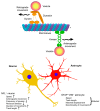Role of Intermediate Filaments in Vesicular Traffic
- PMID: 27120621
- PMCID: PMC4931669
- DOI: 10.3390/cells5020020
Role of Intermediate Filaments in Vesicular Traffic
Abstract
Intermediate filaments are an important component of the cellular cytoskeleton. The first established role attributed to intermediate filaments was the mechanical support to cells. However, it is now clear that intermediate filaments have many different roles affecting a variety of other biological functions, such as the organization of microtubules and microfilaments, the regulation of nuclear structure and activity, the control of cell cycle and the regulation of signal transduction pathways. Furthermore, a number of intermediate filament proteins have been involved in the acquisition of tumorigenic properties. Over the last years, a strong involvement of intermediate filament proteins in the regulation of several aspects of intracellular trafficking has strongly emerged. Here, we review the functions of intermediate filaments proteins focusing mainly on the recent knowledge gained from the discovery that intermediate filaments associate with key proteins of the vesicular membrane transport machinery. In particular, we analyze the current understanding of the contribution of intermediate filaments to the endocytic pathway.
Keywords: endocytosis; exocytosis; intermediate filaments; intracellular trafficking; membrane traffic; mitosis; vimentin.
Figures


References
-
- Hesse M., Magin T.M., Weber K. Genes for intermediate filament proteins and the draft sequence of the human genome: Novel keratin genes and a surprisingly high number of pseudogenes related to keratin genes 8 and 18. J. Cell Sci. 2001;114:2569–2575. - PubMed
-
- Rogers M.A., Edler L., Winter H., Langbein L., Beckmann I., Schweizer J. Characterization of new members of the human type II keratin gene family and a general evaluation of the keratin gene domain on chromosome 12q13.13. J. Investig. Dermatol. 2005;124:536–544. doi: 10.1111/j.0022-202X.2004.23530.x. - DOI - PubMed
-
- Szeverenyi I., Cassidy A.J., Chung C.W., Lee B.T., Common J.E., Ogg S.C., Chen H., Sim S.Y., Goh W.L., Ng K.W., et al. The human intermediate filament database: Comprehensive information on a gene family involved in many human diseases. Hum. Mutat. 2008;29:351–360. doi: 10.1002/humu.20652. - DOI - PubMed
Publication types
Grants and funding
LinkOut - more resources
Full Text Sources
Other Literature Sources

